I never really thought much about tongues until I started raising chickens myself. One morning, sipping my morning coffee, I watched my feathered friends peck away at their chicken feed, and a thought struck me—how exactly do they eat? Like many homesteaders, I wanted a self-sufficient lifestyle, so I had already learned about the digestive process, but I had never noticed their tongues before.
Unlike other animals, a chicken’s tongue is small but plays a key role in moving food down the throat. Whether it’s meat chickens or an older laying hen, their tongues work with the gizzard and crop to break down food.
Watching their natural behaviors, I realized how fascinating they are—not just for sustenance, but also for entertainment. It’s easy to overlook simple things, but raising chickens isn’t just about processing them for food; it’s about understanding their habits and forming a sense of companionship with these quirky creatures.
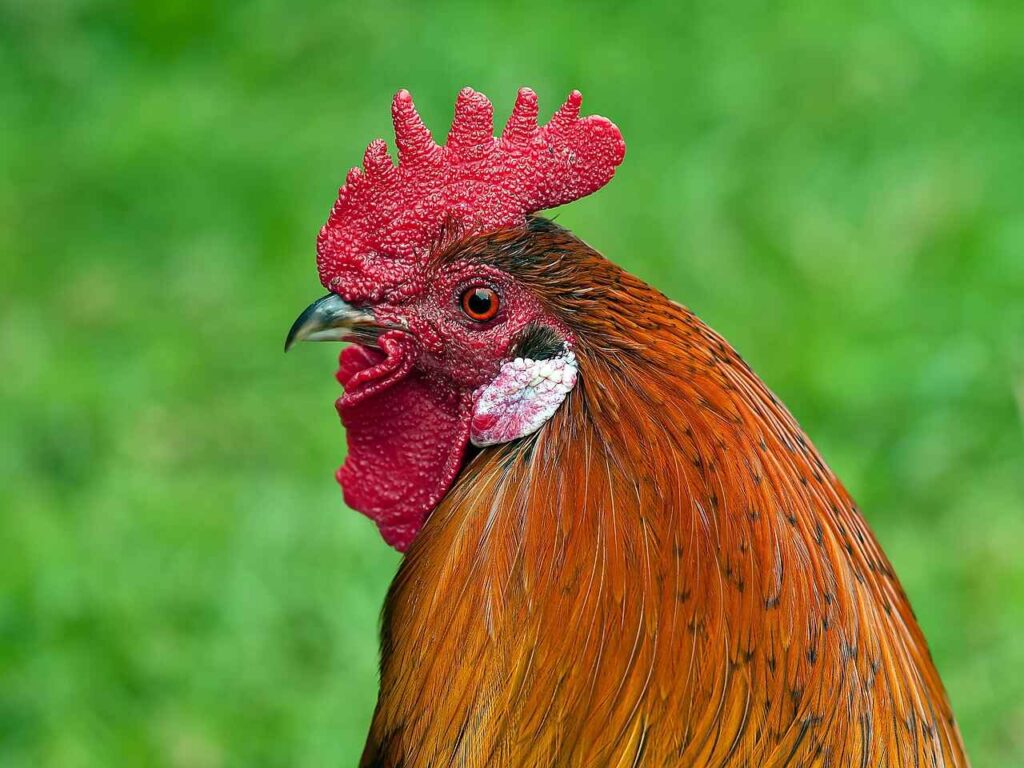
Table of Contents
ToggleDo Chickens Have Tongues?
Most people don’t realize that chickens have tongues, but they do! Unlike mammals, their tongues are a triangle-shaped muscle that fits neatly inside their beak. You rarely notice it because they spend most of their time pecking, scratching, and clucking with other birds.
However, if you ever watch a rooster let out a loud cock-a-doodle-doo, you might see its tongue protrudes slightly from the bottom of its mouth. Chickens belong to the galliform family, which means they share similar tongue structures with turkeys, quail, and pheasants. Their tongues are structured very differently compared to what we’re used to seeing, making their anatomy a fascinating part of science.
What Does A Chicken Tongue Look Like?
A chicken tongue is quite different from what most people expect. It has a triangular shape that fits neatly within the lower beak, making it difficult to see unless you get up close.
The rough surface is covered in tiny hardened hairs and bumps, similar to a cat’s tongue, though it serves a different purpose than a sandpaper tongue. Its pale color often blends with the inside of the mouth, making it even harder to notice.
If you’ve never seen one before, it’s understandable since most animals don’t have tongues shaped like this, leaving many without a frame of reference. Seeing it in personal experience really highlights how unique these tiny,
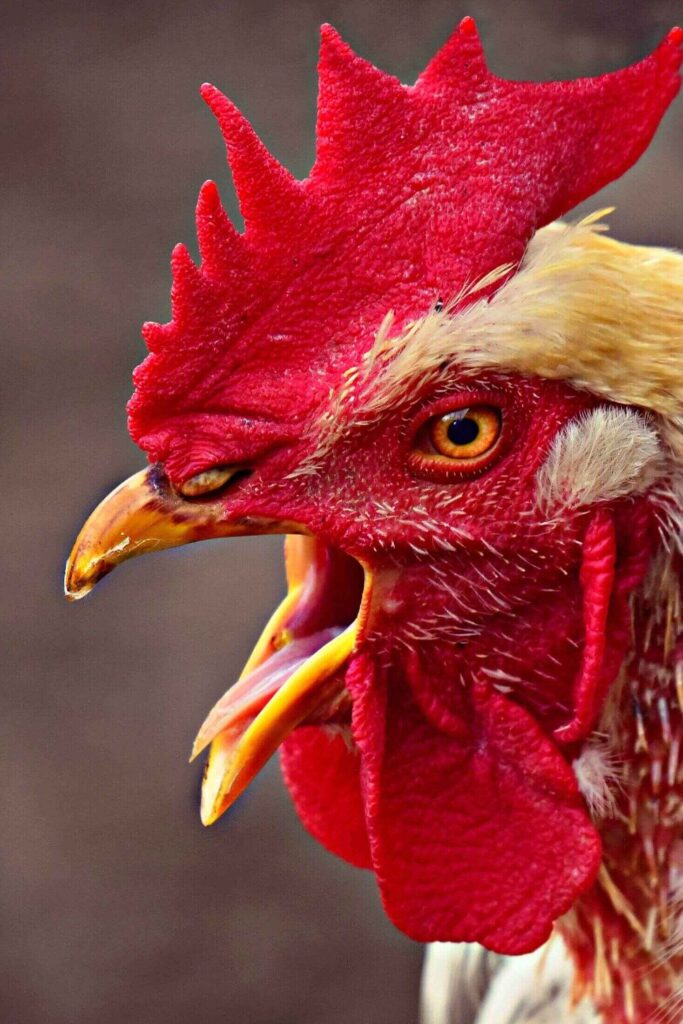
What Is A Lingual Nail?
At the tip of a chicken’s tongue, there is a small, hardened structure known as the lingual nail. This unique feature helps chickens grip their food, making it easier to swallow.
Made of keratin, the same protein that forms their feathers, claws, and even our own hair and nails, this structure plays a vital role in how a bird’s mouth functions. While it may not be as noticeable as other parts of a chicken’s anatomy, this tiny adaptation is key to their ability to eat efficiently.
Do Chickens Have Taste Buds?
Many people wonder if chickens have taste buds, and the answer is yes, but not like humans. While we have around 10,000 taste buds, chickens only have between 240 and 360, mostly found in their mouths, oral cavity, and throats rather than on their tongue.
These feathery friends can recognize different flavors, including sour, bitter, umami, and even salty, but their ability to detect sweet is limited. Interestingly, meat birds like broiler breeds and laying types have varying numbers of receptors, with younger birds generally having more than older ones.
Chickens are also better at tasting dissolved substances in water rather than dry additives, which might explain why they prefer fresh food. Their sense of taste may not be as strong as ours, but their flock instinct is powerful—just shake a bag of treats, and they’ll come running!
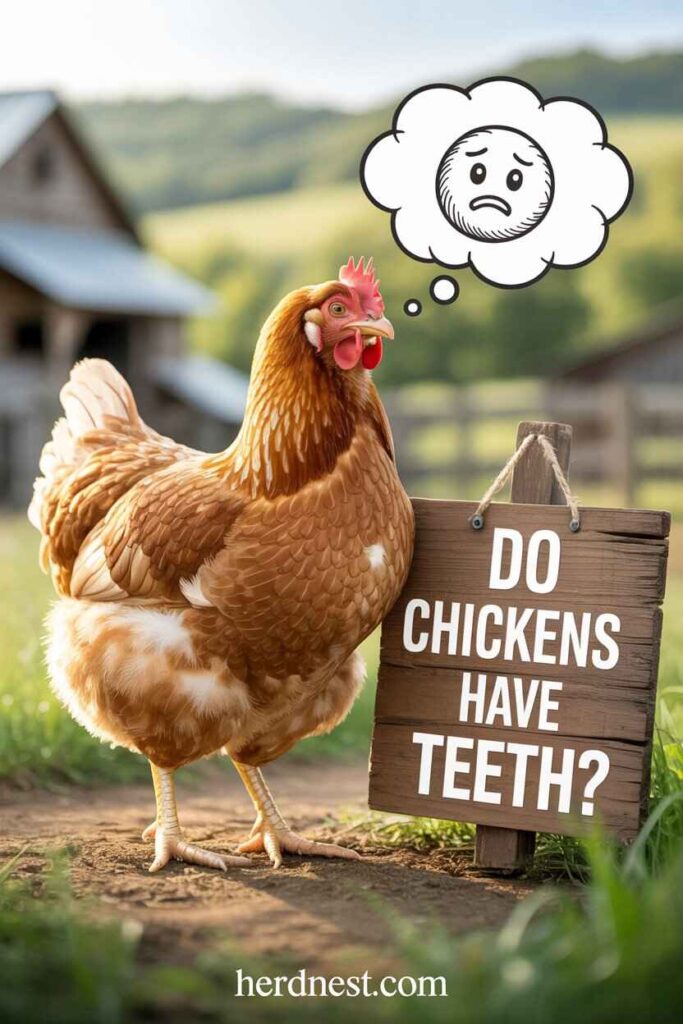
Do Chickens Have Teeth?
Unlike most birds, chickens don’t have teeth, but they’ve adapted a unique way to process food. Instead of chewing, they peck and grab their meals using their beaks, breaking them into smaller particles.
Once swallowed, the food moves to the crop, where it softens before entering the stomach. The real digestion happens in the gizzard, a muscular organ filled with stones and grit that help grind food through mechanical grinding.
As the food breaks down, digestive enzymes assist in the breakdown, ensuring everything becomes edible. Even though they lack teeth, their system is efficient, allowing them to swallow, bite, and even tear into food with ease.
How Chickens Taste Their Food or Tasting
Many people don’t realize that chickens use their tongues for tasting, just like we do. Their taste buds help them determine if food is edible or possibly toxic, which is an important evolutionary adaptation for survival.
While their sense of taste isn’t as strong as ours, these feathery friends still rely on their beaks and throats to help them process flavors to some extent. Unlike mammals, their taste receptors are not just on the tongue but spread throughout different parts of the mouth, making their way of experiencing flavors quite unique.
How Chickens Swallow Their Food
Over time, chickens have evolved to eat without chewing, relying on their tongues and beaks to move food toward the esophagus, where it is swallowed. Unlike mammals, these birds use a peck-feeding style, breaking large pieces into smaller bits before guiding them to the gizzard.
The texture of their tongue prevents sliding backward, ensuring food moves in the right direction. When drinking water, they don’t use their tongues but instead scooping it up with their beak, then tipping their heads back to let gravity do the work. Their mouth plays a crucial role in eating, making their feeding process highly efficient.
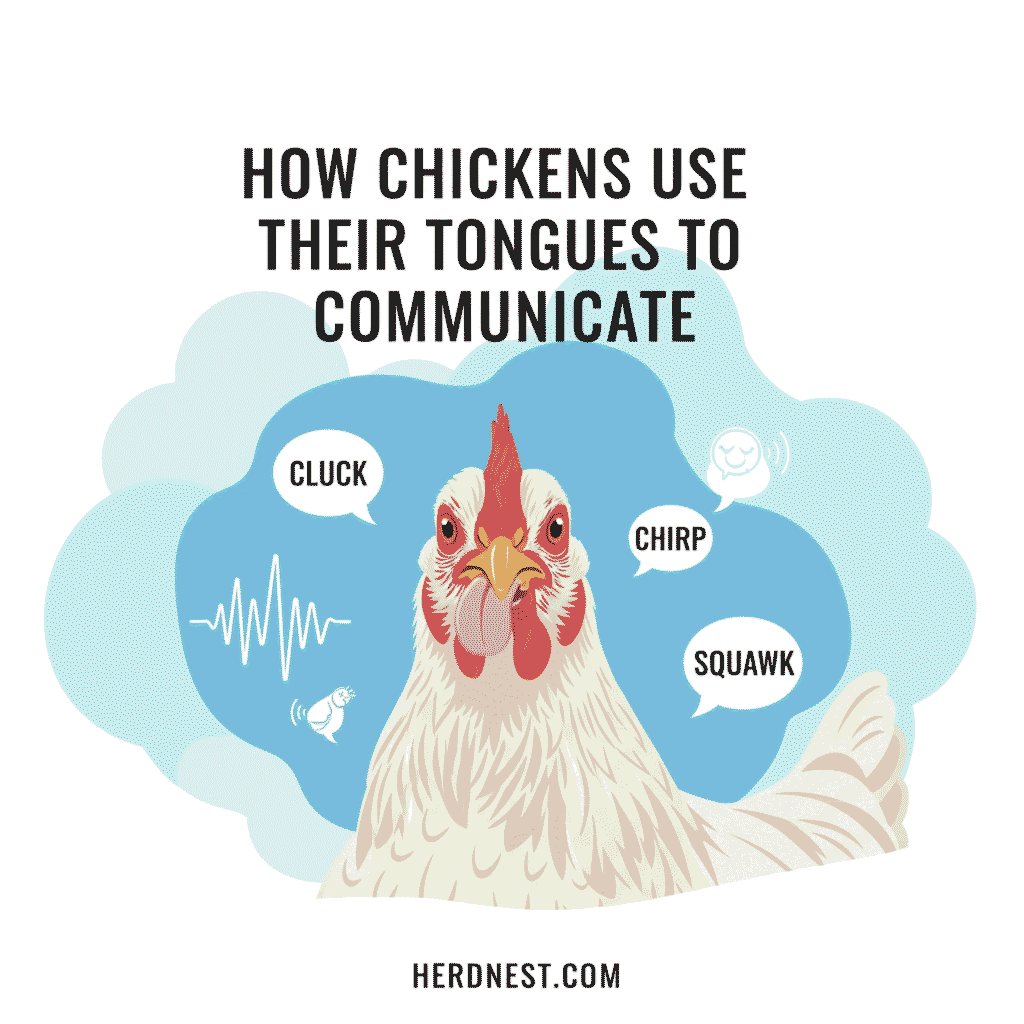
How Chickens Use Their Tongues to Communicate
Chickens are highly social animals that rely on a mix of vocal cues and physical movements to communicate with their flock. From the gentle purring of a broody hen to the loud squawking of a startled bird, their ability to produce different sounds helps them send messages about danger, food, or even excitement.
A rooster may use his voice to guide first-time layers, while hens sing egg-laying songs after laying. Some even believe that chickens use their tongues to fine-tune certain sounds, shaping their unique barnyard mixtapes of chatter.
Whether it’s the warning cry of a hawk overhead, the sharp dinosaur shriek of a startled bird, or the cheerful call of dinner time, each sound has meaning. Their syrinx, the part of their body responsible for sound, works with muscles and air to create these noises. Spending time with chooks helps you understand their dynamic language, making speaking chicken feel like second nature.
How Chickens Use Their Tongues for Foraging
When chickens go foraging, their tongues play a bigger role than you might think. While their sharp beak provides precision in picking up food, their tongue helps manipulate what they catch, whether it’s a slimy worm, a grasshopper, or even a long piece of hay.
The tip of their tongue, known as the lingual nail, is rigid and works with lateral barbs to move pellets, bugs, and other feedstuff toward the throat. Unlike other animals, chickens don’t lap up water with their tongues. Instead, they use their mouth to scooping it up, then tilt their head back, letting gravity pull the water down naturally.
The Chicken Tongue And Beyond
Many people don’t realize that a chicken’s tongue isn’t the only thing helping it eat. Inside its mouth, the choanal slit and glottis work together to direct food down the esophagus while keeping the windpipe clear.
The choanal split sits at the roof of the mouth, allowing air passage from the nasal cavity to the trachea, helping with breathing. The choanal papillae, which should be rigid and not rounded or dull, play an important role in overall health.
A blunt appearance in this area can even signal Vitamin A deficiency. These details make poultry anatomy fascinating beyond their flighty nature, proving their feeding process is more complex than it seems.
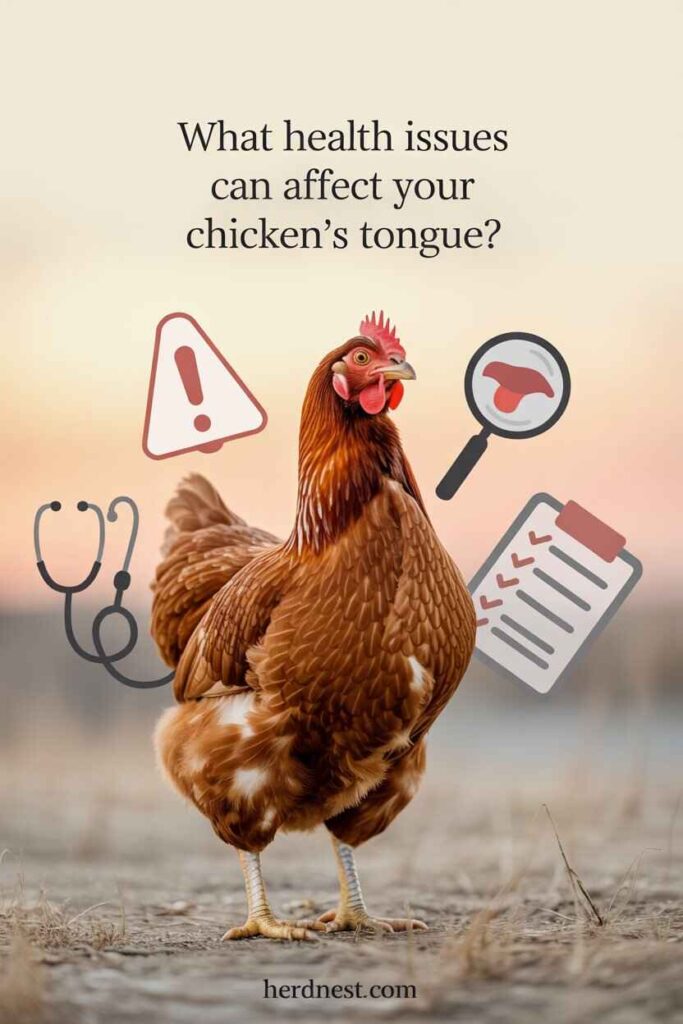
What Health Issues Can Affect Your Chicken’s Tongue?
A chicken’s tongue can reveal more about its health than most people realize. Along with examining the wings, feet, and vent, looking inside the beak can provide valuable insight into potential problems.
Conditions like black tongue or fowlpox can be early signs of ailments that might require a vet’s attention. A choking or ill bird may also show unusual tongue color or swelling, which is why experienced chicken keepers check even the hidden parts of their birds to ensure they stay in good condition.
Understanding poultry anatomy is essential for spotting issues early and keeping your flock healthy.
What Health Issues Can Affect Your Chicken’s Tongue?
Health issues like Black Tongue and Fowl Pox can affect your chicken’s tongue by causing discoloration, swelling, or sores, which may indicate underlying infections or nutritional problems.
Fowl Pox and Its Effect on Chickens
Fowl pox is a virus that affects chickens, causing lesions on the skin, comb, wattles, and even inside the mouth and tongue. In severe cases, it can impact the upper GI and respiratory tracts, leading to a diphtheritic form of infection.
This disease spreads through biting insects, dander, feathers, scabs, and blood, making prevention crucial. While there is no treatment, vaccinations at 12-16 weeks can help protect the flock.
Infected birds should be placed in quarantine to stop the spreading within the coop. Fortunately, most chickens recover within 2-3 weeks, but keeping their internal organs healthy is essential for a full recovery.
Black Tongue in Chickens
A black tongue in chickens is often caused by niacin deficiency, which can be fatal if left untreated. This condition affects laying hens, leading to weight loss, reduced egg production, and poor hatch rates.
While commercial feeds usually contain enough Vitamin B5, rescued birds or those on an unbalanced diet may lack this essential vitamin. To prevent issues, adding beets, fish, and sunflower seeds to their feed can help boost niacin levels.
Waterfowl like geese also require niacin, but many overlook that chicks need it too. Ensuring a balanced diet is key to keeping your feathery friend healthy and thriving.
Final Thoughts on Chicken Tongues
Yes, chickens do have tongues, and they play an integral role in their digestive system and overall health. While certain ailments and issues can be alarming for any keeper, a well-maintained coop, proper nutrition, and access to clean water can prevent many problems from infiltrating the flock. Though caring for chickens may sometimes feel stressful, paying attention to their tongue can be a useful indicator of their well-being.




